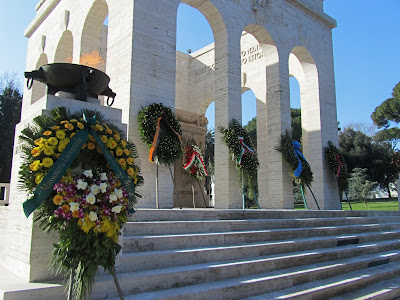Here in Rome we can’t set foot outside the door or even look out the window without coming up against history. In our case, out the window is the base of the Janiculum Hill, the Gianicolo. In ancient times it held the gateway to the Via Aurelia and maybe the house where Cleopatra stayed. But its more recent history is critical to the existence of modern Italy and not far out of living memory. We attended a ceremony yesterday that made me delve a bit farther into what happened in our backyard.
February 9th is the anniversary of the founding of the short-lived Roman Republic in 1849, a major step toward the ultimate formation of a unified Italian nation. The Roman Republic was the result of a popular uprising against Pope Pius IX, who ruled Rome as part of the Papal States. Among the strictures enforced by the pope was the prohibition against practicing any religion except Catholicism or Judaism. The pope fled from Rome, and in his absence a new constitution was declared which provided freedom of religious choice, the right to vote (declared grounds for excommunication by the pope), abolishment of capital punishment and other liberalizing reforms. You can read more detail here.
 |
| Pope Pius IX, 1846. |
The pope called on Catholic countries to come to his aid, and Louis Napoleon, despite the French constitution, sent troops to drive out the upstarts in Rome. The Roman Republic’s volunteer military force, with young men from all over the Italian peninsula, was led by Giuseppe Garibaldi. The defense of Rome took place on the Janiculum Hill, which rises to the west of the city. The Garibaldini, as they are often called, withstood the French siege throughout May and June of 1849 but were finally forced to negotiate a truce and withdraw after heroic fighting but overwhelming casualties.
Each year on February 9th there is a ceremony on the Gianicolo to honor and remember those defenders of nascent Italy. Yesterday was the 163rd anniversary, and we walked up the hill to observe the memorials, which began at the mausoleum and ossuarium built to honor the caduti, the fallen.
 |
| The mausoleum. |
In addition to an honor guard from the modern Italian army and two carabinieri (military police) in dress uniform, there were veterans from specialist and historic army groups, some in uniforms of another time. The bersaglieri corps (high-mobility marksmen) were easy to pick out with their distinctive black-feathered head gear. Regimental banners and floral wreaths remembered Garibaldini from many parts of the Italian peninsula. Also in attendance were several classes of high school students who were supposed to learn a history lesson in a more tangible way than in a classroom.
 |
| Above, part of the army honor guard. Below, a veteran in an historic uniform. |
 |
| An unmistakeable feathered bersaglieri. |
The primary speaker was a retired general who gave us a wonderfully animated summary of the political history and the battle to defend the 19th century Roman Republic. Then Anita Garibaldi, the great granddaughter of heroic Giuseppe Garibaldi and the namesake of his wife, appealed to the patriotism of today’s generation, telling us (and especially i studenti) to rise above the problems of modern Italy in the spirit of the audacious defenders of Rome from a century and a half ago.
 |
| The retired general and the great granddaughter of Anita Garibaldi, flanked by carabinieri. |
After an enthusiastic rendition of the Italian national anthem, the entire assembly left the mausoleum, walking up Via Garibaldi to the top of the Gianicolo to lay wreaths at both the monumental statue honoring Giuseppe Garibaldi and at the one nearby for his wife, Anita, who was also fully involved in the battles.
 |
| The procession walks up Via Garibaldi and... skirts an overlook with the Vittorio Emanule II monument in the background. |
 |
| The monument to Giuseppe Garibaldi. |
 |
| Anita Garibaldi's monument. |
It’s a bit humbling to live next to such an important historical site. Not many physical remnants reflect the deadly battles fought on the Gianicolo, but almost every street in our neighborhood of Trastevere bears the name of a fallen hero. We live on the corner of Via Luciano Manara and Via Goffredo Mameli. Manara was a bersaglieri from Milan, Garibaldi’s chief of staff, who died at age 24. Mameli was from Genoa, a patriot/poet who wrote the words to what is now the Italian national anthem. He died from a gangrenous battle wound at age 22 and is interred in the big mausoleum on the hill. When I walk through the hilltop park, many of the fallen keep me company in the form of white busts that line the paths, putting faces to the names. I don’t know whether the history lesson had any effect on the high schoolers at the ceremony, but it made me take a closer look at some of those statues.
Roberto
 |
| Villa Vascello, one of the few buildings left that show signs of the 1849 battles. |
 |
| The bust of Luciano Manara with others of the Garibaldini atop the Gianicolo. |




Molto interessante! Ed io ero qua!
ReplyDelete